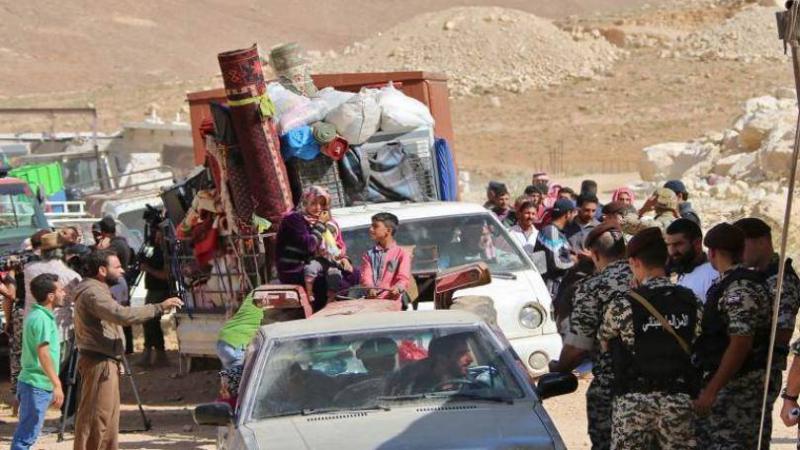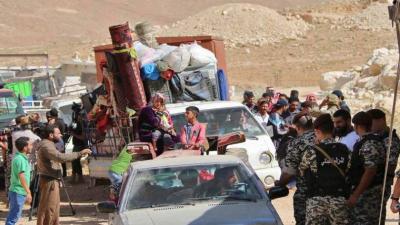Between voluntariness and coercion, they gather a lifetime of displacement that began with the first wave in March 2011, coinciding with the outbreak of war in Syria. They return either to the unknown or to what is already known. So far, the known aspect of voluntary return has included 511 displaced persons out of one and a half million, according to a plan set by the Lebanese government in 2017, which was halted during the COVID-19 pandemic in 2020 but resumed on October 12 of last year, with the first batches returning from the Arsal camp in coordination between the Lebanese and Syrian governments, under the supervision of the General Security in a plan described as "safe and voluntary." However, this voluntary return has not lived up to the label of "safe." According to documented reports from the Syrian Network for Human Rights, in November of last year, the regime’s forces arrested about 106 Syrians, including displaced persons who returned to their homes within the regime's control and opposition members who had settled their security situations in Syria. The report adds that the arrests, kidnappings, forced disappearances, and raids have taken on a vengeful nature, focusing on provinces that witnessed opposition activity against the regime since 2011, such as Aleppo, Rural Damascus, Daraa, Homs, and Idlib. In addition to the regime's abuses, other factions, including the Syrian Democratic Forces, Hay'at Tahrir al-Sham, and the National Army, arrested around 90 civilians, 60 of whom were forcibly disappeared.
The return may not be compulsory in the literal sense, but the conditions in which the displaced persons live in the Arsal camp have transformed it into a compulsion amid the daily struggle to secure the simplest necessities of life, including drinking water and food, aside from living conditions that have become nearly impossible in recent years. Reports indicate that the first batch of returning displaced persons is from the towns of Qalamoun, Nabek, Qara, and the surgeons in western Syria. While it was expected that about 750 Syrian refugees would leave Lebanon, the number has so far not exceeded 511 according to a statement from the General Security. Will voluntary and safe returns resume amid reports of the Syrian regime's practices against returning opposition members and displaced persons, or will it halt again, this time under the pretext of protecting human rights?
Former Minister Ma'in al-Murabi, who previously warned of the consequences of returning displaced persons without guarantees, stated to "Al-Markaziah" that the timing of the return plan was not innocent, coinciding with a plan serving the interests of the Syrian regime. "After practices of kidnapping, arrest, forced disappearance, and killing, the recruitment of returning displaced persons into the ranks of Russian mercenary militias for combat in the war against Ukraine began, motivated by financial incentives. It is known that the fate of these individuals is death in battlefields, as is the case for the majority of mercenaries in conflicts." Furthermore, there is a new trend of recruiting Syrian students studying in Russian universities into militia ranks after Russian President Vladimir Putin issued a decree to recruit about 300,000 personnel, with assistance from displaced persons and Syrian students present in Russia, following the refusal and fleeing of many young Russian men from military service. We possess documented information on this matter.
According to international treaties and Lebanon's commitment as a founding member of human rights organizations, the Lebanese state is prohibited from sending any displaced person or refugee of any nationality to death. "What is required from security agencies is to adhere to these treaties and ensure the safety of returnees before sending them back to their homes… if they do indeed return to their homes," says al-Murabi, noting that the majority are sent to other areas after the Assad regime has confiscated their lands and homes, turning their villages into strongholds for Hezbollah and their families, where they have established captagon factories and stockpiles of weapons and missiles.
Between the reality that compels Lebanon to return Syrian displaced persons due to economic, living, and financial conditions and the burden of hosting one and a half million displaced individuals, the humanitarian situation and the fate of returning displaced persons raise the question: What is required? Al-Murabi responds: "A clear plan for the return of Syrian displaced persons must be put in place, and the reliance on ‘begging’ at the expense of the displaced must stop. As for the number, I challenge any official to state that there are one and a half million displaced persons. The number does not exceed 500,000, while the rest are workers who enter and exit Lebanese territory without accountability through illegal crossings controlled by Hezbollah militia."
"If there is a transparent and objective plan, it should begin with controlling illegal crossings; however, the state is unable to manage smuggling and movement through illegal crossings dominated by captagon and drug gangs." Al-Murabi concludes by affirming the dual intention among both Lebanese and Syrian peoples regarding the return of displaced individuals to their villages. "I was personally assured of this by the people of Qalamoun, but due to their inability to return to their homes now under the control of regime forces, they requested to return to 'Jarabulus' at the Turkish-Syrian border. However, Turkish authorities refused, considering that this operation is part of a root-cutting policy and violates the texts and principles of the United Nations, as it contributes to demographic changes that are already underway in Syria by Hezbollah."




